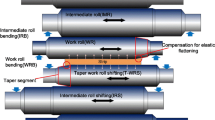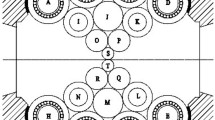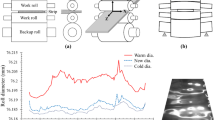Rational reduction and tension schedules and roll profiles for 150/500×400 four-high reversing mill and 350×450 two-high reversing mill were developed and studied to increase the output of strips of high accuracy. For the 150/500×400 mill, increasing the work roll crown from +0.1 to +0.15 mm, the specific back tension from 0.12–0.16 to 0.14–0.18 МРа, and the specific front tension from 0.16–0.18 to 0.18–0.20 MPa appeared to decrease the transverse thickness deviation of strips by 10% compared with the conventional reduction and tension schedules. For the 350×450 mill, increasing the work roll crown from +(0.04–0.07) to +0.09 mm, the specific back tension from 3.3 to 8.7 MPa, and the specific front tension from 4.44 to 10.0 МРа appeared to decrease the transverse thickness deviation of 1-mm strips to 0.039 mm, which may be considered high accuracy. A mathematical model is proposed to analyze the stress-strain state of wavy strips with allowance for hardening. The numerical modeling showed that the tangential stresses are maximum on the upper and lower faces of a 0.5h1 strip, while the radial stresses are maximum in the neutral plane of the strip.



Similar content being viewed by others
References
“International nonferrous metal market review,” Tsvet. Met., No. 1, 4–8 (2016).
Yu. N. Raikov, G. V. Ashikhmin, V. P. Polukhin, and A. S. Gulyaev, Handbook of Copper Alloys, Inst. Tsvetmetobrabotka, Moscow (2011).
R. L. Shatalov, “Improving the quality of strips made of nonferrous metals and alloys,” Tsvet. Met., No. 5, 65–70 (2001).
Yu. F. Shevakin, V. N. Chernyshev, R. L. Shatalov, and N. A. Mochalov, Metal Forming, Intermet, Moscow (2005).
E. A. Maksimov, R. L. Shatalov, and A. S. Lukash, “Flatness stability of a strip undergoing elastoplastic bending during rolling,” Chern. Met., No. 10, 9–13 (2011).
R. L. Shatalov, E. A. Maksimov, and E. Yu. Verkhov, “Rational control of the flatness of strips during rolling,” in: Proc. 2nd Int. Sci.-Tech. Conf. Technological Advance in the Iron-and-Steel Industry, Oct. 7–9, 2015, Cherepovets, Cherepovets Gos. Univ. (2015), pp. 212–215.
Author information
Authors and Affiliations
Corresponding author
Additional information
Translated from Metallurg, No. 7, pp. 77–81, July, 2017.
Rights and permissions
About this article
Cite this article
Shatalov, R.L., Maksimov, E.A. & Lukash, A.S. Development of Rational Reduction Schedules and Roll Profiles in Simulating the Rolling of Thin Copper Strips. Metallurgist 61, 591–596 (2017). https://doi.org/10.1007/s11015-017-0538-1
Received:
Published:
Issue Date:
DOI: https://doi.org/10.1007/s11015-017-0538-1




